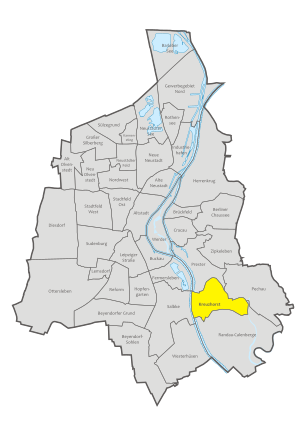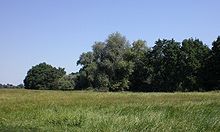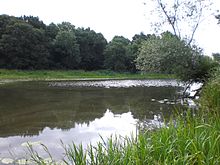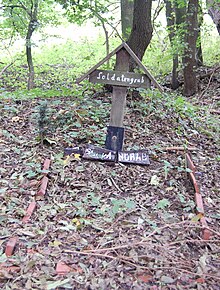Kreuzhorst
|
Kreuzhorst district of Magdeburg |
|
|---|---|
| Basic data | |
| Surface: | 4.724 km² |
| Residents : | 0 |
| Population density : | 0 inhabitants per km² |
| (Information as of December 31, 2016) | |
| Coordinates : | 52 ° 5 ' N , 11 ° 42' E |
| District / District: | Kreuzhorst |
| Postcodes : | no postal addresses |
The Kreuzhorst is one of 40 districts of Magdeburg in Saxony-Anhalt (Germany). The district is located on the right bank of the Elbe in the southeast of Magdeburg. A large part (approx. 2.82 km²) of the Kreuzhorst is designated as a nature reserve Kreuzhorst (NSG 16).
geography
The Kreuzhorst covers an area of 4.7241 km² and is uninhabited. In the west the Kreuzhorst borders on the Elbe , in the north on Prester , in the east on Pechau and in the south on Randau-Calenberge . The area is crossed by an old tributary of the Elbe. Other bodies of water in the area are the Kuhlenhagen , the Mönchseen , the Mönchsgraben and the Franzosengraben .
The Pechau forest cemetery is located on the eastern border of the Pechau district .
history
Origin of name
The name could have been derived from Dietrich von Groiz or Dietrich von Groitsch , a previous owner of Gut Kulenhagen , which was already located in the forest area in the Middle Ages , and then developed from Groizhorst / Groitschhorst via Cruisenhorst to today's Kreuzhorst. The fact that parts of the area had belonged to the monastery of Our Dear Women in Magdeburg and thus to the church since the 11th century may also play a role . It also seems conceivable that the monastery built a wayside cross, for example in the area where the Alter and Neuer Elbe rivers meet, and that is how the name came about. However, the name Kreuzhorst is not mentioned in medieval documents. The forest area is only described as the forest belonging to Salbke or the Kulenhagen farm is named.
In the vicinity of the Old Elbe and on the border to Randau, several parcels of land bear the name Peddau , which suggests a deserted village of the same name.
middle Ages
In the 10th century, the main river of the Elbe still flowed east of the Kreuzhorst, in other words in the area of today's Old Elbe. The Kreuzhorst was still on the left bank of the Elbe at that time. Before 1012 the bed of the still existing main stream was built west of the Kreuzhorst. For the year 1016 the forest opposite Salbke was described as being enclosed by the old and new Elbe. Since then the Kreuzhorst has been on the island of Elbenauer Werder . In 1015 or 1016 Archbishop Gero bequeathed the forest near Salbke and another 10 Hufe fields near Salbke to the foundation of the monastery of Our Dear Women. In the 12th century, the monastery increased its forest holdings through purchase and exchange. In 1189, the monastery acquired the Kulenhagen estate, thus rounding off its property in the area. In Salbke there was ultimately the Salbke monastery estate , which also took over the management of the Kreuzhorst. The connection across the Elbe was made via the monastery ferry . The residents were parish in the Salbker church . When the management of the estate ceased in the middle of the 19th century, the monastery ferry was no longer operated and was replaced by the Salbke ferry.
Modern times
During the Thirty Years' War , Magdeburg armed forces built three entrenchments to defend the city in 1631 in the Kreuzhorst area and the surrounding area. To the north, near the confluence of the Dornburg Old Elbe and the Elbe, in the area of the so-called Rehberg, was the Trutz Tilly ski jump . The Magdeburg Succurs was located further south on a meadow in the Kreuzhorst . Outside the Kreuzhorst, east of Pechau, the third ski jump Trutz Pappenheim was built. All three entrenchments were stormed by imperial / catholic troops, the crews were almost completely killed. On May 20, 1631 Magdeburg was finally stormed and destroyed .
Around the first half of the 19th century, the pedagogy of the monastery of Unserer Lieben Frauen began to celebrate the Kreuzhorstfest in the Kreuzhorst once a year . Students and teachers drove from Salbke across the Elbe, probably in August every year. There was singing and then breakfast. After playing games, the students had lunch in the open air. Teachers and officials of the monastery then had their lunch in the forester's house. Music was played in the afternoons and sporting competitions such as balancing, climbing, throwing, jumping and running were held. Three oak trees were felled between the games, at least that's what it is for 1843. In later years only one oak was reported to be felled. You then went back to the forester's house. After dinner, they went back in a boat on the Elbe with music and singing. The tradition of the Kreuzhorst festivals lasted into the 20th century.
Gut Kulenhagen was in operation as a forester's house for the area until around 1880. The forester's house no longer exists today. During this time, the large Elbe dike was built, which runs through the district from north to south, with the forest area east of the dike, on the side facing away from the Elbe. The entire area remained in the ownership of the monastery or its legal successors until the middle of the 20th century.
In 1917 the state agency for the preservation of natural monuments in Berlin placed four of the strongest trees in the Kreuzhorst, which were 5 to 5½ meters in circumference, under protection. The remote location of the Kreuzhorst in spite of its proximity to the city may also have led to the fact that in 1923 two hundred groups , some of whom were armed with rifles, and were closely related to the Red Front Fighters' Association , which was later founded , drilled in the area of the Kreuzhorst.
The Kreuzhorst did not belong to a municipality for a long time, but formed the manor district Salbke-Kreuzhorst . On December 1, 1928, the manor district was incorporated into Magdeburg. Salbke had been part of the city since 1910, and Pechau, bordering the Kreuzhorst, was not incorporated into the city until 1994.
Since around the 1930s, a festival of Magdeburg water sports enthusiasts, known as the Meckerndorf , has taken place northwest of the Kreuzhorst, in the area around the Mönchsgraben, on a weekend every year . A press report on this has come down to us from 1935. Canoeists and sailors, for whom the area of the Mönchsgraben was and is very popular, created a village square with stalls and tents, including a town hall, tavern and monument. The villagers came with their boats and built a large tent city. The mayor gave a cabaret speech, the baptism of newcomers to Neptune was carried out and then celebrated late into the night. In the end, the town hall traditionally burned down. The last moaning village took place in 1956. On September 3rd, the tents were broken up again. An official ban on this event is not known, but it was no longer carried out.
Second World War
At the end of the Second World War, even greater fighting occurred in the area of the Kreuzhorst. US troops had reached Westerhüsen on April 12, 1945 . From 9:30 p.m. they crossed the Elbe in the area of the Westerhüsen ferry and formed a bridgehead in the area of the Prinzenwiese on Holz- and Kapitelwerder south of the Kreuzhorst. In the early morning hours of April 13, an American patrol advanced through the Kreuzhorst to check whether the bridge over the Elbarm near Pechau was still intact. About a kilometer west of the bridge, however, a German outpost manned by six men was found. At around 9:30 a.m., the US units received the order from the bridgehead that had been formed from the ferry station to the north towards the bridge, a second group to advance towards Randau. At 11 o'clock a company, A Company, advanced along the path leading north from the ferry and reached the Elbe dike. After crossing the dam, the unit caught a heavy fire and withdrew behind the dike. During this, another company, the C-Company, moved directly east from the area of the ferry and only then swung north towards Pechau. At first she met no resistance. Shortly before this company reached the Pechauer bridge, a heavy firefight ensued. Six German and three American soldiers died and 30 Germans were taken prisoner. The US troops crossed the intact bridge in a train and formed a bridgehead on the Pechau side. American artillery fired a barrage on the area around Pechau . Unaware of the depth of the American advance, about 40 German soldiers came quickly from Pechau to the bridge to intervene in the suspected fighting south of the bridge. They had to withdraw with losses. Parts of the US units now turned west to attack the German units from behind, which had stopped the further advance of A Company on the Elbe dike northeast of the ferry. The German units also withdrew here with losses.
The US troops, which had meanwhile advanced to Randau, found the place free from the military and were able to take the village without a fight. In front of Pechau there were new battles, as five German assault guns with mounted infantry attacked the small American bridgehead at the Pechau bridge. Surprisingly, German assault guns also appeared on the right side of A Company, and an armored vehicle was also fired from the left. The German guns belonged to Assault Gun Brigade 234 from Burg, which attacked the US troops from Gommern across the Elbe. Since the US troops lacked anti-tank defense, they withdrew behind the Elbe dike, which acted as a natural anti-tank barrier, to their original position, which was reached at 7:00 p.m. Randau was also evacuated again. The actually intended creation of a pontoon bridge over the Elbe in the area of the ferry was prevented by sustained German artillery fire. Reinforcing and supplying the US troops in the bridgehead was therefore difficult. The US troops therefore relocated their bridgehead from 9 p.m. to the south in the area in front of Schönebeck and left the Kreuzhorst area. Later the Schönebeck bridgehead was completely cleared. With the arrival of Soviet troops from the east at the beginning of May 1945, the Second World War and the Nazi tyranny also ended in the Kreuzhorst area.
A soldier's grave preserved in the forest goes back to these events. In an autobiography, the German soldier Roman Heindorf describes the situation in Kreuzhorst in the second half of April 1945.
Time in the GDR
The Salbke ferry was discontinued during the GDR era . Since then, the connection to the west bank of the Elbe has only existed via the Westerhüsen ferry, just a little further south. At least in the 1950s, a tug called Kreuzhorst was in use on the Elbe . In 1961 a large part of the area (3.2 km²) was placed under nature protection by the GDR. Later the area became part of the Middle Elbe landscape protection area . In particular, the Fahlberg-List chemical plant on the opposite side of the Elbe also caused considerable environmental pollution. In GDR literature from the 1970s, for example, reference was made to the harmful effects of the "exhaust gases from VEB Fahlberg List". Above all, "smoke damage" was reported to the oak trees in the area. However, similar reports had been made many decades earlier. The plant stopped production in 1995.
In 1962, the Pechau forest cemetery was built on an agricultural plot on the border with Pechau .
Flora and fauna
flora
The Kreuzhorst has an extensive ash - elm - floodplain forest . However, there are also common oak , field maple , elm , small-leaved lime , large-leaved lime , sycamore maple , Norway maple , beech , black alder , white willow , wild pear and wild apple on.
In the 1850s, the botanist Paul Ascherson also traveled to Kreuzhorst, among other places. In 1864 he published his work on the flora of the province of Brandenburg, the Altmark and the Duchy of Magdeburg in which he also listed the finds made by him and his collaborators in the Kreuzhorst. Accordingly, the following plants in the Kreuzhorst were native to that time: Hypericum hirsutum , bladder sedge , wood anemone , Chaeturus marrubiastrum , Real centaury , Festuca adscendens Yellow water lily , bird cherry , Common Water crowfoot , gratiola officinalis , High Wolf Trapp , dog-wheat , Comb quail wheat , garlic hederich , cabbage leek , long-leaved blue loosestrife , Myosotis caespitosa , reclining crow's foot , whorled thousand-leaf , sand plantain , shield speedwell , snake leek , chunky sedge , skewer skullcap , jumping foam herb , stiff barbara herb , Marsh Ragwort , Marsh Skullcap , Marsh Pea , Bank Sedge , Water Ragwort , Vineyard Leek , White Water Lily , Meadow Gold Oat , Angular Sedge and Scattered Forget-Me-Not . Particularly noteworthy is the occurrence of the Hohen Wolfstrapp, which was found in 1856 by the local employees Banse and Schneider in the northwestern part of the Kreuzhorst and was already considered very rare. Today the Hohe Wolfstrapp is considered to be extinct or lost in Germany. In June 1866 the occurrence of the ditch violet was found on the Kreuzhorstwiesen.
fauna
There are 32 species of mammals , including beavers , weasels , bats and polecats , with 16 species on the red list .
Furthermore, 90 breeding bird species were found. There is a colony of gray herons . The lesser spotted eagle also breeds here. There are also about 210 migrating bird species.
3000 species of butterflies and 168 different species of weevils (including hero buck and stag beetle ) live in the Kreuzhorst. In 2012 the presence of the beetle species hermit was detected. In addition to 11 species of fish, including the endangered wolffish , 3 reptile species and 12 amphibian species also live in the Kreuzhorst . The occurrence of alien animal species such as raccoon dogs , mink and raccoons is problematic .
A variety of dragonfly species can also be found in the Kreuzhorst. So were Asian Clubtail , white-legged damselfly , Beautiful Demoiselle , hawker , Ruddy Darter , Brown Hawker , Falk dragonfly , variable damselfly , damselfly , hairy dragonfly , Banded darter , banded demoiselle , yellow-winged darter , spotted somatochlora , Common Emerald Damselfly , Common Blue Damselfly , vagrant darter , Common winter damsel , Lestes Dryas , brilliant emerald , Great Binsenjungfer , common darter , Great Emperor Dragonfly , tailed damselfly , black-tailed skimmer , Great damselfly , migrant hawker , Azure damselfly , wedge spot dragonfly , small red-eyed damselfly , Little Emperor Dragonfly , Plattbauch , top spot and Vierfleck noted. In 1977 the spear azure maiden was also found, but has not been detected again since then.
In 2016 wolf sightings were reported in the Kreuzhorst area.
legend
The legend of The Holy Oak in the Kreuzhorst takes place in the Kreuzhorst and tells of a friendly encounter between the 12th century Archbishop of Magdeburg, Norbert von Xanten, and the pagan god Thor . Then the Archbishop, returning home from a trip, went on a long hike through the Kreuzhorst on a late summer afternoon. In doing so, he came across a large open area. Surrounded by slender beeches and oaks, a large, mighty ancient oak stood in the middle. Under the tree there was a flower garden with rose and lilac bushes and beds with Levkoien , Reseda , red carnations and white lilies. Norbert von Xanten sat down on a moss bench next to a linden tree. From the branches and leaves there was a faint whisper reminiscent of the sounds of a page. Norbert was moved, knelt down, prayed and got into deep devotion. He was startled when suddenly there was a violent storm with lightning and thunder. When he was about to leave quickly, an old man with a long white beard and long white hair stepped in his way. The old man was dressed in a lion's skin and held a short staff in his right hand. With the staff he stopped the storm and introduced himself as Thor. He told Norbert not to be afraid that he was under the protection of the holy oak. Thor regretted that the people, seduced by Norbert and his priests, had turned away from him. But he is not angry about it. The people are like a playing child and love change. Even if millennia passed - in the end one would return to him. Norbert, who is known as strict, should, however, beware of his own people and envious priests. Should he ever be persecuted, he could flee into the sacred grove and bless the consecrated oak. Thor suddenly disappeared, leaving only a small white staff. When Norbert picked him up, it shone at one end so that the archbishop found his way out of the forest through the night. Before that, however, he blessed the tree and announced that everyone should lay their hands on it, that it would be death and that the oak was the asylum for the persecuted and the horrors of persecution. The next day, Norbert von Xanten went to the Kreuzhorst again, but could not find the tree again and thought it was a dream. A year later it became known that attempts to fell an oak tree in the Kreuzhorst had failed and that several had paid with their lives for the attempt. Norbert von Xanten hurried on site, but found only one large but normal oak. In order to combat superstition , Norbert wanted to cut the tree himself. However, when the ax was struck, it came loose from its handle and disappeared. The archbishop put a cross on the tree and ordered the oak to be protected.
The oak was later forgotten again. In 1324 an unhappy pair of lovers walked through the Kreuzhorst. Rosa Wilbrand , daughter of a Magdeburg silk merchant, had been engaged to the stingy leather merchant Wahrfeld since childhood , whom she was to marry in four weeks. However, she loved Bruno von Eichelberg . Both thought about thwarting the marriage. In the Kreuzhorst, the two were attacked by a group of masked men and sought protection behind an oak tree. As soon as one of the attackers touched the tree with his lance, he fell dead to the ground. While one attacker escaped, another was killed by Bruno. To the surprise it was found that the attacker was Rosa's fiancé, who had tried to kill his rival. Rosa and Bruno got married. The old cross attached by Norbert von Xanten was discovered on the oak.
Web links
Individual evidence
- ↑ Kreuzhorst. Nature reserves in Saxony-Anhalt. State Administrative Office of Saxony-Anhalt, accessed on April 17, 2018 .
- ↑ Willy Otto Riecke: Chronicle Prester-Cracau. Self-published, Magdeburg 1932, p. 238.
- ^ Pastor M. Riemer, History of the Alumnate in The Monastery of Our Dear Women in Magdeburg in the Past and Present , Self-published by the Monastery, Magdeburg 1920, page 168
- ↑ Maik Hattenhorst, Magdeburg 1933 , Mitteldeutscher Verlag Halle (Saale) 2010, ISBN 978-3-89812-775-2 , page 32
- ↑ Heinz Tietge, The Buckau-Fermersleben Water Sports Association , Part 1 1911-1961, Magdeburg 2011, page 175 ff.
- ^ Peter Wittig: Elbe operation. Beyer Verlag Sachsen for Culture and History, Dresden 2009, ISBN 978-3-9809520-0-2 , p. 29f.
- ^ Peter Wittig: Elbe operation. Beyer Verlag Sachsen for Culture and History, Dresden 2009, ISBN 978-3-9809520-0-2 , p. 44ff.
- ^ Roman Heindorf, Simple Past , BoD-Books on Demand 2002, ISBN 978-3831130825
- ↑ Heinz Tietge: The Buckau-Fermersleben Water Sports Club , Part 1 1911-1961, Magdeburg 2011, p. 182.
- ↑ Magdeburg and its surroundings (= values of our homeland . Volume 19). 1st edition. Akademie Verlag, Berlin 1973, p. 196.
- ↑ Death in the Kreuzhorst In: Volksstimme . August 26, 1931.
- ^ Paul Ascherson, Flora of the Province of Brandenburg, the Altmark and the Duchy of Magdeburg, Third Department, Special Flora of Magdeburg, published by August von Hirschwald Berlin 1864
- ^ Paul Ascherson, Flora of the Province of Brandenburg, the Altmark and the Duchy of Magdeburg, Third Department, Special Flora of Magdeburg, Verlag von August von Hirschwald Berlin 1864, page 85
- ^ Journal for the total natural sciences , year 1866, 28th volume, Wiegandt and Hempel Berlin 1866, page 184
- ^ Matthias Jentzsch, Lutz Reichhoff, Handbook of the Fauna-Flora-Habitat-Areas of Saxony-Anhalt , publisher, State Office for Environmental Protection Saxony-Anhalt, Halle (Saale) 2013, ISBN 978-3-00-042711-4 , page 133
- ↑ Rosemarie Steglich, Paul-Ludwig Gentz, Libellenatlas , State Capital Magdeburg Environment Agency, 2002
- ↑ Michaela Schröder, Was it the wolf? in Magdeburg Volksstimme on May 26, 2016, page 13
- ↑ WARelßieg, myths and legends of the city of Magdeburg and the surrounding area ff, Volume 2, Frynta'sche Buchdruckerei 1847, page 391st
- ^ Olaf Meister , local legends from Westerhüsen and the surrounding area , epubli Berlin 2019, ISBN 978-3-748572-28-2 , page 68 ff.












